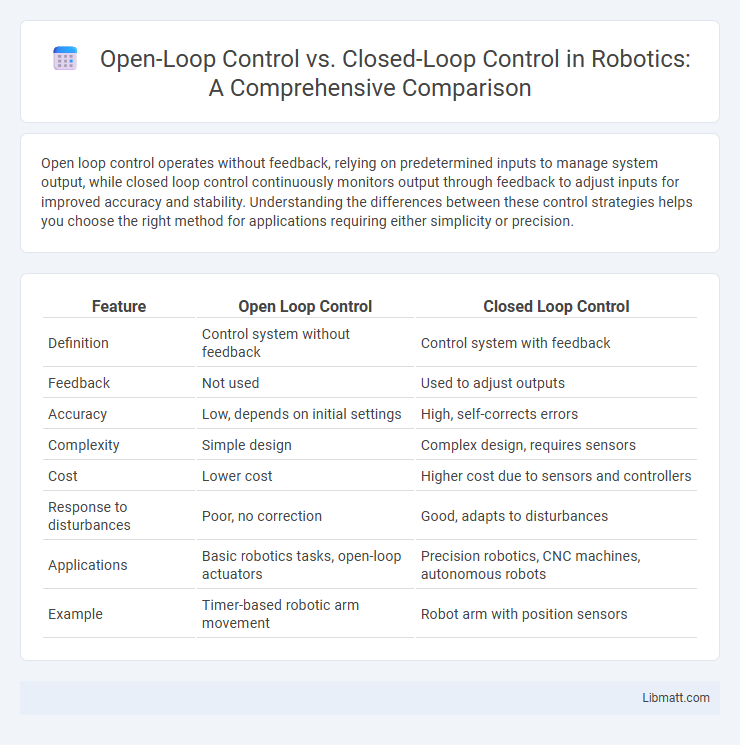Open loop control operates without feedback, relying on predetermined inputs to manage system output, while closed loop control continuously monitors output through feedback to adjust inputs for improved accuracy and stability. Understanding the differences between these control strategies helps you choose the right method for applications requiring either simplicity or precision.
Table of Comparison
| Feature | Open Loop Control | Closed Loop Control |
|---|---|---|
| Definition | Control system without feedback | Control system with feedback |
| Feedback | Not used | Used to adjust outputs |
| Accuracy | Low, depends on initial settings | High, self-corrects errors |
| Complexity | Simple design | Complex design, requires sensors |
| Cost | Lower cost | Higher cost due to sensors and controllers |
| Response to disturbances | Poor, no correction | Good, adapts to disturbances |
| Applications | Basic robotics tasks, open-loop actuators | Precision robotics, CNC machines, autonomous robots |
| Example | Timer-based robotic arm movement | Robot arm with position sensors |
Introduction to Control Systems
Open loop control systems operate without feedback, relying solely on predetermined inputs to drive output actions, which makes them simpler but less accurate in dynamic conditions. Closed loop control systems use feedback mechanisms to continuously monitor output and adjust inputs accordingly, enhancing precision and stability in response to disturbances. Control systems form the foundation of automation and robotics, optimizing performance by managing process variables through either open or closed loop configurations.
Defining Open Loop Control
Open Loop Control refers to a system where the control action is independent of the output or system feedback, relying solely on predefined inputs. This type of control is simpler, faster, and less expensive but may lack accuracy since it cannot correct deviations or disturbances during operation. Common examples include basic home appliances like washing machines or microwave ovens that operate on set timers without sensor feedback.
Understanding Closed Loop Control
Closed loop control systems continuously monitor output feedback to automatically adjust inputs, enhancing system accuracy and stability. This real-time feedback loop allows your system to correct errors and maintain desired performance despite external disturbances. Closed loop control is essential in applications requiring precision, such as temperature regulation, robotics, and automotive cruise control.
Key Differences Between Open Loop and Closed Loop
Open Loop Control systems operate without feedback, relying solely on predefined inputs to execute functions, which limits their ability to correct errors during operation. Closed Loop Control systems incorporate feedback mechanisms that constantly monitor output and adjust inputs to maintain desired performance, enhancing accuracy and adaptability. The primary difference lies in feedback usage: Open Loop lacks it, making it simpler but less precise, while Closed Loop uses feedback to achieve dynamic correction and improved system stability.
Advantages of Open Loop Control Systems
Open loop control systems offer simplicity and cost-effectiveness, as they do not require feedback sensors or complex monitoring components. These systems provide faster response times and are easier to design and implement in applications with predictable and stable operating conditions. Open loop control is advantageous in processes where output accuracy is not critical, reducing maintenance and operational overhead.
Advantages of Closed Loop Control Systems
Closed loop control systems offer precise regulation by continuously monitoring output and adjusting inputs to maintain desired performance, reducing errors and improving accuracy. These systems enhance stability and adaptability to external disturbances or system variations, ensuring consistent operation under changing conditions. Your process benefits from increased efficiency, reliability, and responsiveness due to real-time feedback and automatic corrections.
Common Applications of Open Loop Control
Open loop control systems are commonly used in applications where precision feedback is unnecessary, such as simple household appliances like washing machines and irrigation systems. These systems operate based on predefined commands without real-time monitoring, making them cost-effective and easy to implement for tasks with predictable outcomes. Your automation projects benefit from open loop control when the environment is stable and disturbances are minimal.
Common Applications of Closed Loop Control
Closed loop control systems are commonly used in applications requiring precise regulation and adaptability, such as temperature control in HVAC systems, speed control in electric motors, and automated manufacturing processes. These systems continuously monitor output through sensors and adjust inputs to maintain desired performance despite disturbances. Your ability to achieve consistent accuracy and stability in dynamic environments depends heavily on the closed loop control's feedback mechanism.
Limitations and Challenges of Each System
Open loop control systems face limitations such as lack of feedback, making them vulnerable to disturbances and unable to correct errors, leading to reduced accuracy in dynamic environments. Closed loop control systems, while capable of self-correction through feedback, encounter challenges like increased complexity, potential instability due to improper tuning, and slower response times. Both systems require careful consideration of application requirements to balance simplicity, accuracy, and robustness.
Choosing the Right Control System for Your Application
Selecting the appropriate control system depends on the specific requirements of accuracy, responsiveness, and system complexity. Open loop control offers simplicity and cost-effectiveness for applications with predictable, consistent processes, while closed loop control provides higher precision and adaptability through real-time feedback, ideal for dynamic environments. Factors such as environmental variability, load disturbances, and desired control quality determine whether an open loop or closed loop system is optimal for achieving efficient and reliable performance.
Open Loop Control vs Closed Loop Control Infographic

 libmatt.com
libmatt.com